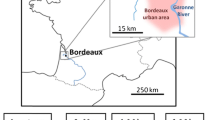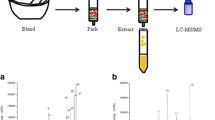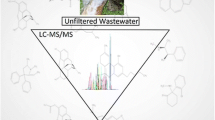Abstract
Two solid-phase extraction methods were systematically studied to determine 32 pharmaceuticals and personal care products in water and sediments by ultrahigh-performance liquid chromatography–tandem mass spectrometry. One involves HLB cartridges activated with sodium dodecyl sulfate before the passage of the sample to form an ion pair with cationic analytes, and the other uses mixed HLB–cation exchange cartridges. The accuracy of the sodium dodecyl sulfate method was good for most compounds (recoveries of 61–120% with relative standard deviation less than 23%). However, the recoveries for atorvastatin, codeine, paracetamol, flufenamic acid, and salicylic acid were approximately 50% and for omeprazole and triclocarban were even lower (from 0 to 12%). The detection limits were 1.65–25 ng L-1 in water and 0.33–4.00 ng g-1 (dry weight) in sediment. The recoveries for the mixed-mode cartridge (Strata-X-CW) method ranged from 57% to 120% with relative standard deviation less than 21%, with the exception of codeine [25% (water)], metformin [11% (sediment)], paracetamol [48% (sediment)], and salicylic acid [32% (sediment)]. The detection limits were 1.65–38.35 ng L-1 in water and 0.33–10 ng g-1 (dry weight) in sediment. Both methods followed the same pattern when applied to water. For sediments, the recoveries, which offer good performance, were not very high, although 60% of the compounds had recoveries greater 80%. The methods were applied to the analysis of surface water and sediments from the Albufera Natural Park (Spain). Twenty-seven of 32 analytes were detected in the samples analyzed.





Similar content being viewed by others
References
Carmona E, Picó Y. The use of chromatographic methods coupled to mass spectrometry for the study of emerging pollutants in the environment. Crit Rev Aanal Chem. 2018;48(4):305–16.
Miller TH, Bury NR, Owen SF, MacRae JI, Barron LP. A review of the pharmaceutical exposome in aquatic fauna. Environ Pollut. 2018;239:129–46.
Zenker A, Cicero MR, Prestinaci F, Bottoni P, Carere M. Bioaccumulation and biomagnification potential of pharmaceuticals with a focus to the aquatic environment. J Environ Manage. 2014;133:378–87.
Bonnefille B, Gomez E, Courant F, Escande A, Fenet H. Diclofenac in the marine environment: a review of its occurrence and effects. Mar Pollut Bull. 2018;131:496–506.
Carvalho RN, Ceriani L, Ippolito A, Lettieri T. Development of the first Watch List under the Environmental Quality Standards Directive. Luxembourg: Publications Office of the European Union; 2015.
Pavlidis G, Ploumistou E, Karasali H, Liapis K, Anagnostopoulos C, Charalampous A, et al. Evaluation of the water quality status of two surface water reservoirs in a Mediterranean island. Environ Monit Assess. 2018;190(10):570.
Kidd KA, Burkhard LP, Babut M, Borgå K, Muir DCG, Perceval O, et al. Practical advice for selecting or determining trophic magnification factors for application under the European Union Water Framework Directive. Integr Environ Assess. 2018;0(0).
Campo J, Lorenzo M, Pérez F, Picó Y, Farré ML, Barceló D. Analysis of the presence of perfluoroalkyl substances in water, sediment and biota of the Jucar River (E Spain). Sources, partitioning and relationships with water physical characteristics. Environ Res. 2016;147:503–12.
Huguenot D, Bois P, Jézéquel K, Cornu J-Y, Lebeau T. Selection of low cost materials for the sorption of copper and herbicides as single or mixed compounds in increasing complexity matrices. J Hazard Mater. 2010;182(1):18–26.
Dabrowski A, Hubicki Z, Podkościelny P, Robens E. Selective removal of the heavy metal ions from waters and industrial wastewaters by ion-exchange method. Chemosphere. 2004;56(2):91–106.
Gadd GM. Metals, minerals and microbes: geomicrobiology and bioremediation. Microbiology. 2010;156(3):609–43.
Souza-Silva ÉA, Jiang R, Rodríguez-Lafuente A, Gionfriddo E, Pawliszyn J. A critical review of the state of the art of solid-phase microextraction of complex matrices I. Environmental analysis. Trends Anal Chem. 2015;71:224–35.
Masiá A, Vásquez K, Campo J, Picó Y. Assessment of two extraction methods to determine pesticides in soils, sediments and sludges. Application to the Túria River Basin. J Chromatogr A. 2015;1378:19–31.
Menya E, Olupot PW, Storz H, Lubwama M, Kiros Y. Production and performance of activated carbon from rice husks for removal of natural organic matter from water: a review. Chem Eng Res Des. 2018;129:271–96.
Fatta-Kassinos D, Vasquez MI, Kümmerer K. Transformation products of pharmaceuticals in surface waters and wastewater formed during photolysis and advanced oxidation processes – degradation, elucidation of byproducts and assessment of their biological potency. Chemosphere. 2011;85(5):693–709.
Matilainen A, Sillanpää M. Removal of natural organic matter from drinking water by advanced oxidation processes. Chemosphere. 2010;80(4):351–65.
Boras JA, Vaqué D, Maynou F, Sà EL, Weinbauer MG, Sala MM. Factors shaping bacterial phylogenetic and functional diversity in coastal waters of the NW Mediterranean Sea. Estuar Coast Shelf Sci. 2015;154:102–10.
Klosterhaus SL, Grace R, Hamilton MC, Yee D. Method validation and reconnaissance of pharmaceuticals, personal care products, and alkylphenols in surface waters, sediments, and mussels in an urban estuary. Environ Int. 2013;54:92–9.
Carmona E, Andreu V, Picó Y. Multi-residue determination of 47 organic compounds in water, soil, sediment and fish—Turia River as case study. J Pharm Biomed Anal. 2017;146:117–25.
Andrés-Costa MJ, Rubio-López N, Morales Suárez-Varela M, Pico Y. Occurrence and removal of drugs of abuse in wastewater treatment plants of Valencia (Spain). Environ Pollut. 2014;194:152–62.
Leendert V, Van Langenhove H, Demeestere K. Trends in liquid chromatography coupled to high-resolution mass spectrometry for multi-residue analysis of organic micropollutants in aquatic environments. Trends Anal Chem. 2015;67:192–208.
Siddiqui MR, AlOthman ZA, Rahman N. Analytical techniques in pharmaceutical analysis: a review. Arab J Chem. 2017;10:S1409–21.
Chinnaiyan P, Thampi SG, Kumar M, Mini KM. Pharmaceutical products as emerging contaminant in water: relevance for developing nations and identification of critical compounds for Indian environment. Environ Monit Assess. 2018;190:288.
Masiá A, Campo J, Blasco C, Picó Y. Ultra-high performance liquid chromatography–quadrupole time-of-flight mass spectrometry to identify contaminants in water: An insight on environmental forensics. J Chromatogr A. 2014;1345:86–97.
Vazquez-Roig P, Blasco C, Picó Y. Advances in the analysis of legal and illegal drugs in the aquatic environment. Trends Anal Chem. 2013;50:65–77.
Biel-Maeso M, Corada-Fernández C, Lara-Martín PA. Determining the distribution of pharmaceutically active compounds (PhACs) in soils and sediments by pressurized hot water extraction (PHWE). Chemosphere. 2017;185:1001–10.
Gerssen A, McElhinney MA, Mulder PPJ, Bire R, Hess P, de Boer J. Solid phase extraction for removal of matrix effects in lipophilic marine toxin analysis by liquid chromatography-tandem mass spectrometry. Anal Bioanal Chem. 2009;394(4):1213–26.
Lavén M, Alsberg T, Yu Y, Adolfsson-Erici M, Sun H. Serial mixed-mode cation- and anion-exchange solid-phase extraction for separation of basic, neutral and acidic pharmaceuticals in wastewater and analysis by high-performance liquid chromatography–quadrupole time-of-flight mass spectrometry. J Chromatogr A. 2009;1216:49–62.
Omar TFT, Ahmad A, Aris AZ, Yusoff FM. Endocrine disrupting compounds (EDCs) in environmental matrices: review of analytical strategies for pharmaceuticals, estrogenic hormones, and alkylphenol compounds. Trends Anal Chem. 2016;85:241–59.
Alvarez-Muñoz D, Huerta B, Fernandez-Tejedor M, Rodríguez-Mozaz S, Barceló D. Multi-residue method for the analysis of pharmaceuticals and some of their metabolites in bivalves. Talanta. 2015;136:174–82.
Paíga P, Correia M, Fernandes MJ, Silva A, Carvalho M, Vieira J, et al. Assessment of 83 pharmaceuticals in WWTP influent and effluent samples by UHPLC-MS/MS: hourly variation. Sci Total Environ. 2019;648:582–600.
Fatoki OS, Opeolu BO, Genthe B, Olatunji OS. Multi-residue method for the determination of selected veterinary pharmaceutical residues in surface water around livestock agricultural farms. Heliyon. 2018;4:e01066.
Álvarez-Ruiz R, Andrés-Costa MJ, Andreu V, Picó Y. Simultaneous determination of traditional and emerging illicit drugs in sediments, sludges and particulate matter. J Chromatogr A. 2015;1405:103–15.
Carmona E, Andreu V, Picó Y. Occurrence of acidic pharmaceuticals and personal care products in Turia River Basin: from waste to drinking water. Sci Total Environ. 2014;484:53–63.
Fu F, Wang Q. Removal of heavy metal ions from wastewaters: a review. J Environ Manage. 2011;92(3):407–18.
Tandy S, Bossart K, Mueller R, Ritschel J, Hauser L, Schulin R, et al. Extraction of heavy metals from soils using biodegradable chelating agents. Environ Sci Technol. 2004;38(3):937–44.
Giebułtowicz J, Stankiewicz A, Wroczyński P, Nałęcz-Jawecki G. Occurrence of cardiovascular drugs in the sewage-impacted Vistula River and in tap water in the Warsaw region (Poland). Environ Sci Pollut Res Int. 2016;23:24337–49.
Pérez-Carrera E, Hansen M, León VM, Björklund E, Krogh KA, Halling-Sørensen B, et al. Multiresidue method for the determination of 32 human and veterinary pharmaceuticals in soil and sediment by pressurized-liquid extraction and LC-MS/MS. Anal Bioanal Chem. 2010;398:1173–84.
Cirilli R, Ferretti R, Gallinella B, De Santis E, Zanitti L, La Torre F. High-performance liquid chromatography enantioseparation of proton pump inhibitors using the immobilized amylose-based Chiralpak IA chiral stationary phase in normal-phase, polar organic and reversed-phase conditions. J Chromatogr A. 2008;1177:105–13.
Acknowledgements
The research that led to these results received funding from the Spanish Ministry of Science, Innovation and Universities and the European Regional Development Fund through the project WETANDPAC (RTI2018-097158-B-C31) and from the Generalitat Valenciana through the project ANTROPOCEN@ (PROMETEO/2018/155). Daniele Sadutto acknowledges the Generalitat Valenciana for his Santiago Grisolia grant: “GRISOLIAP/2018/102, Ref CPI-18-118.”.
Author information
Authors and Affiliations
Corresponding author
Ethics declarations
Conflict of interest
The authors declare that they have no competing interests.
Additional information
Publisher’s note
Springer Nature remains neutral with regard to jurisdictional claims in published maps and institutional affiliations.
Electronic supplementary material
ESM 1
(PDF 481 kb)
Rights and permissions
About this article
Cite this article
Sadutto, D., Álvarez-Ruiz, R. & Picó, Y. Systematic assessment of extraction of pharmaceuticals and personal care products in water and sediment followed by liquid chromatography–tandem mass spectrometry. Anal Bioanal Chem 412, 113–127 (2020). https://doi.org/10.1007/s00216-019-02207-0
Received:
Revised:
Accepted:
Published:
Issue Date:
DOI: https://doi.org/10.1007/s00216-019-02207-0




